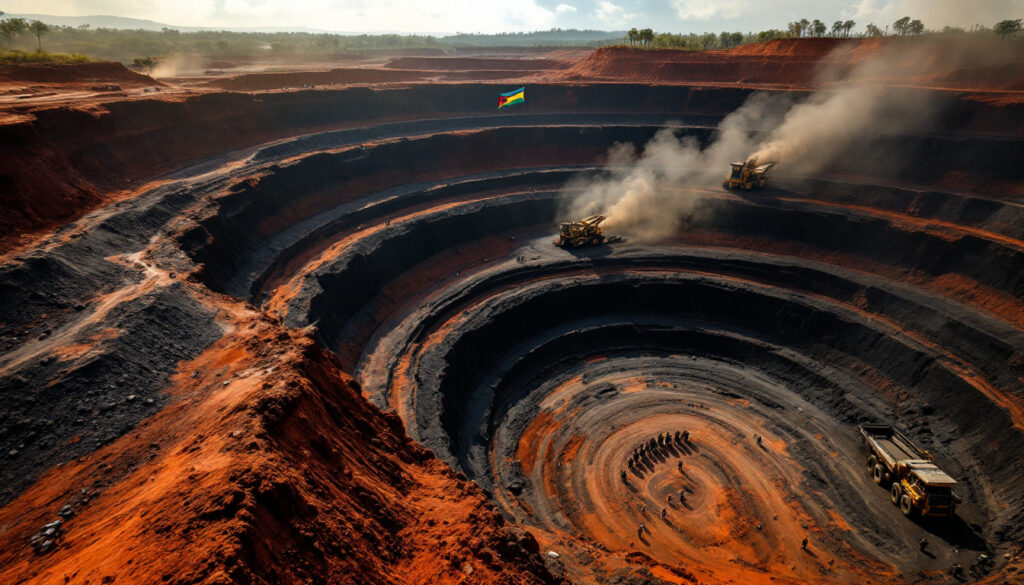Why Are Mozambique's Coal Mines Laying Off Workers?
Mozambique's coal industry faces unprecedented challenges as a perfect storm of global market pressures and local instability forces major mining operations to shed hundreds of workers. Coal futures at South Africa's Richards Bay port have declined approximately 17% since the beginning of 2025, mirroring a global oversupply and reduced demand from key markets like China. This price slump has created immense pressure on mining companies operating in Mozambique, where coal represents the country's largest export commodity.
The post-electoral violence following contested October elections has exacerbated economic challenges for mining operations across the country. Logistics disruptions blocked critical rail corridors to ports for weeks, delaying approximately 500,000 tons of shipments and incurring $50 million in losses. These disruptions came at the worst possible time as companies were already struggling with deteriorating market conditions and coal 2024 challenges.
Adelaide Jantar, provincial inspector at the Ministry of Labor, noted: "We have never had such a huge number of dismissals in recent times. The post-election violence disrupted logistics significantly, exacerbating financial strain for mining companies already dealing with price pressures."
The Richards Bay futures (API4 index), which serve as the benchmark for Mozambican exports, fell to $82 per ton in Q1 2025 from $99 per ton in Q4 2024. This decline reflects broader shifts in global energy markets, with industry analysts projecting global thermal coal demand to drop 10% by 2030 due to renewable energy transitions.
Economic Impact on Mozambique's Largest Export
Coal sales generated $2 billion in 2024, accounting for approximately 15% of national export revenue. This makes the coal sector highly vulnerable to price fluctuations, with immense implications for the national economy. The current industry contraction threatens not just mining operations but Mozambique's overall economic stability.
Mining union representatives emphasize that each job loss impacts between five and seven dependents in mining communities, creating a multiplier effect that threatens regional prosperity. Global commodity insights indicate that EU's thermal coal imports fell 34% in 2024 and China's coal consumption dropped 4.5% amid decarbonization pledges, continuing to put pressure on coal-exporting nations like Mozambique.
How Many Workers Are Being Affected by the Layoffs?
Vulcan's Moatize Mine Workforce Reduction
Vulcan International's Mozambique unit has informed the government of plans to cut 105 workers, representing approximately 3.1% of its workforce. The company currently employs 3,365 people directly at its operations in Tete province, making it one of the region's largest employers. Vulcan cited "restructuring of the company and a fall in coal prices" as reasons for the workforce reduction.
The severance costs for Vulcan are estimated at $1.2 million, reflecting Mozambique's labor laws requiring 30 days' pay per year of service. This significant financial outlay underscores the severity of the economic pressures facing even the largest operators in the region.
Industry-Wide Employment Impact
Beyond Vulcan, other coal mining companies are cutting "hundreds of workers" according to government officials. Industry-wide layoffs exceed 500 as of April 2025, with ripple effects throughout regional economies. The layoffs represent an unprecedented scale of workforce reduction in Mozambique's mining sector.
Tete province's unemployment rate rose to 12.4% in March 2025, up from 9.8% in 2024, highlighting the broad economic impact of the mining downturn. Secondary businesses in Tete, including transport companies and food vendors, report 20-30% revenue declines since layoffs began, demonstrating how mining job losses affect the wider community.
The gender disparity in layoffs is also notable, with approximately 85% of laid-off workers being male. This imbalance creates particular social challenges in communities where male breadwinners have traditionally supported extended families.
What Is the Moatize Mine and Its Significance?
Mozambique's Flagship Coal Operation
Moatize is the country's largest coal mining operation, producing 12 million tons per year and contributing approximately 40% of Mozambique's coal output. Located in Tete province, a key coal-producing region, the operation is critical to Mozambique's position as a coal exporter on the global stage.
The mine holds approximately 1.5 billion tons of coking and thermal coal reserves, with a strip ratio of 4:1. This geological profile makes Moatize significant in terms of both quantity and quality of reserves, though the high sulfur content in some seams has limited access to premium buyers in recent years.
The mine's environmental record has come under scrutiny, with a $2 million fine for water pollution issued in 2023, adding to operational challenges beyond market conditions. Furthermore, the industry has been making significant strides towards a mining decarbonisation shift which adds additional pressure.
Ownership and Recent History
Vulcan International, headed by Indian businessman Naveen Jindal, acquired the Moatize asset from Brazil's Vale SA in late 2021. The acquisition was valued at $270 million and included 25-year mining licenses and 1,300 km of rail infrastructure, representing a significant investment in Mozambique's mining sector.
Upon acquisition, Naveen Jindal, Vulcan CEO, stated: "Moatize anchors our African energy strategy." However, the company inherited challenges that had plagued the previous owner. Vale had invested $4.3 billion in Moatize before divesting due to protracted losses from 2017-2021, illustrating the difficult operating environment even before the current market downturn.
The transfer of ownership represented not just a change in management but also shifting geopolitical interests in African resources, with Indian companies increasingly taking positions previously held by Brazilian and Western mining interests.
How Are Global Coal Markets Affecting Mozambique?
Current Coal Price Trends
Coal prices have been trending downward in 2025, with the 17% decline in Richards Bay coal futures indicating a significant market correction. API4 futures are pricing in a 2025 global surplus of 50 million tons, driven by U.S. and Colombian output flooding the market.
The price slump follows several years of volatility in global energy markets, leaving companies with insufficient reserves to weather the current downturn. High-cost producers like Mozambique are being squeezed first as buyers seek cheaper alternatives.
Energy economist François Garde notes: "Mozambique's high sulfur content limits premium buyers, forcing exporters to accept discounted rates in an already depressed market." This quality disadvantage compounds the effects of the general price decline.
Export Challenges and Market Conditions
Mozambique's $2 billion coal export industry faces pressure not only from declining global demand but also from structural disadvantages. Mozambique's rail-and-port costs average $28 per ton versus $15 per ton for Australian exporters, making the country less competitive in tight markets.
India's Adani Group halted 2 million tons per year of imports from Mozambique in January 2025, switching to Russian suppliers offering more favorable terms. This loss of a major buyer illustrates how quickly market shifts can impact export-dependent operations.
The country's heavy dependence on coal exports makes it particularly vulnerable to price fluctuations, with limited ability to influence global market conditions. As developed nations accelerate their transition to renewable energy, coal-exporting countries like Mozambique face long-term structural challenges beyond cyclical price movements.
What Are the Broader Economic Implications for Mozambique?
Impact on Local Communities and Economy
Mining communities in Tete province face significant economic disruption as layoffs ripple through local economies. Each mining job typically supports multiple service jobs in transportation, retail, and hospitality sectors, creating a multiplier effect for both job creation and job losses.
The scale of layoffs suggests a potential ripple effect throughout regional economies that will be difficult to contain. Local businesses report revenue declines of 20-30% since the mining contraction began, with little prospect for near-term improvement.
Beyond immediate job losses, the social fabric of communities built around mining operations faces significant strain. Schools, healthcare facilities, and other services partially supported by mining companies may face funding gaps as corporate social responsibility budgets contract alongside operations.
National Economic Considerations
Coal contributes 8% of Mozambique's GDP, and analysts project that a 20% export decline could reduce GDP growth by 1.5% in 2025. The metical has depreciated 14% against the USD since January 2025, increasing dollar-denominated mining debts and adding financial pressure on companies.
Government royalties from coal fell to $120 million in Q1 2025 versus $180 million in Q1 2024, straining fiscal budgets already under pressure. The reduced revenue threatens government spending on infrastructure, education, and healthcare at a crucial time.
Central bank governor Rogério Zandamela observed: "Diversification is urgent, but requires 5-10 years to implement effectively." This timeline highlights the challenge facing policymakers—the need for immediate economic responses versus the longer timeframe required for structural economic transformation.
The $20 billion TotalEnergies LNG project (suspended since 2021 due to security concerns) could offset coal losses if resumed, but uncertainty remains about its timeline. Mozambique faces difficult choices about balancing immediate needs against long-term economic resilience amidst ongoing China market impact on resource markets.
FAQ: Mozambique's Coal Industry Crisis
What factors are causing the layoffs in Mozambique's coal mines?
The primary factors include a 17% decline in coal prices since early 2025, post-election violence that disrupted operations, high operational costs compared to competitors, and corporate restructuring by major mining companies including Vulcan International. Global markets show signs of structural oversupply as renewable energy gains market share in traditional coal-importing nations.
How important is coal to Mozambique's economy?
Coal is Mozambique's largest export commodity, generating $2 billion in export revenue in 2024 and contributing approximately 8% to GDP. The industry's health directly impacts government revenue, foreign exchange reserves, and regional employment, particularly in Tete province where mining dominates the local economy.
Who owns the Moatize mine and when did they acquire it?
The Moatize mine is owned by Vulcan International, headed by Indian businessman Naveen Jindal. Vulcan acquired the mine from Brazil's Vale SA in late 2021 for $270 million, including extensive rail infrastructure and long-term mining licenses. The acquisition represented a major shift in ownership from Brazilian to Indian interests.
How many workers are employed at the Moatize mine?
Vulcan directly employs 3,365 people at its operations in Tete province. The announced layoffs of 105 workers represent approximately 3.1% of this workforce. The mine supports thousands of additional indirect jobs through contractors and service providers in the region.
For those interested in understanding how these market conditions might affect investments in this sector, our comprehensive mining stocks guide provides valuable insights for navigating these challenging times.
Looking for Early Investment Opportunities in ASX Mining Discoveries?
Discovery Alert's proprietary Discovery IQ model provides immediate notifications when significant mineral discoveries are announced on the ASX, giving you a crucial market advantage before news spreads. Explore how major mineral discoveries have historically generated substantial returns by visiting the dedicated discoveries page and position yourself ahead of the market.




